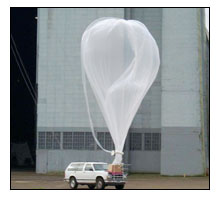SUNNYVALE, Calif., August 11 -- OmniVision Technologies Inc., a supplier of CMOS image sensors, announced that it is collaborating with NASA and the Jet Propulsion Laboratory (JPL) of Pasadena, Calif., to supply image sensors for the Picosat and Uninhabited Aerial Vehicle Systems Engineering (PAUSE) Mars prototype aerobot project. OmniVision also announced that it is supporting the Angstrom Aerospace Corp. (AAC) in Uppsala, Sweden, with imagers for the first microelectromechanical systems- (MEMS) enabled nanosatellite, the MicroLink Nanosatellite project.
As part of the PAUSE Mars aerobot project, OmniVision will supply CameraChips to be used in the imaging systems onboard. PAUSE aerobots are unmanned scientific exploration vehicles (airborne robots) designed to float like balloons for up to several months in the atmosphere of planets and moons, and are equipped to conduct sophisticated observational programs.

A polyethylene balloon gets ready to be launched into the stratosphere by the Jet Propulsion Laboratory and the California Institute of Technology as part of the PAUSE Mars prototype aerobot project. The initial test program was conducted at the facilities of GSSL Inc., a balloon manufacturer in Tillamook, Ore. (Photo GSSL Inc.)
PAUSE aerobots consist of a zero-pressure balloon and a prototype Mars aerobot science microgondola, which includes three OmniVision imagers, multiple temperature sensors, a pressure sensor, a GPS receiver, a 1 GB data storage device and a radio modem. The OmniVision sensors will be used to take images down, to the side and up. The gondola weighs 7.25 lbs and consumes approximately 3 watts of power. The aerobot was recently deployed twice in the Earth's stratosphere at 35 km (21.9 mi.) to simulate the environment on Mars.
MicroLink-1 (formerly called NanoSpace-1), the first nanosatellite (<10 kg), is a new breed of small spacecraft consisting largely of enabling micro- and nanotechnologies. In the upcoming MicroLink space mission, a microsatellite and a nanosatellite are launched jointly; once in orbit the two are separated.
Onboard the spacecraft, OmniVision sensors will be used to take images of Earth and to monitor the satellite separation. The sensors will be packaged into ultraminiaturized MultiChip-Modules. MicroLink-1, currently under development at the AAC, is expected to be launched in 2009.
For more information, visit: www.ovt.com